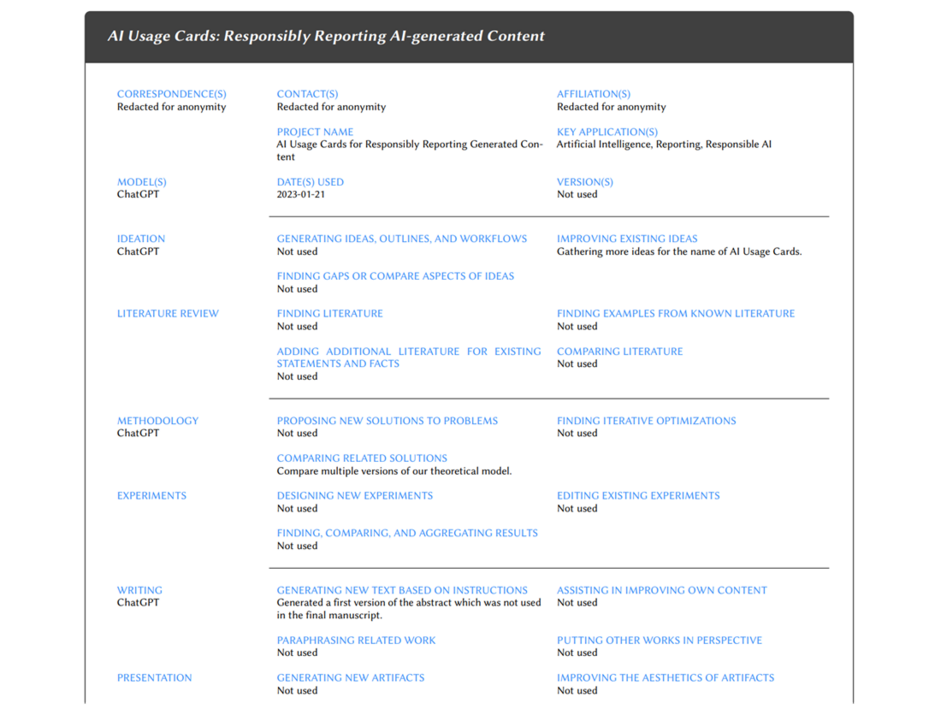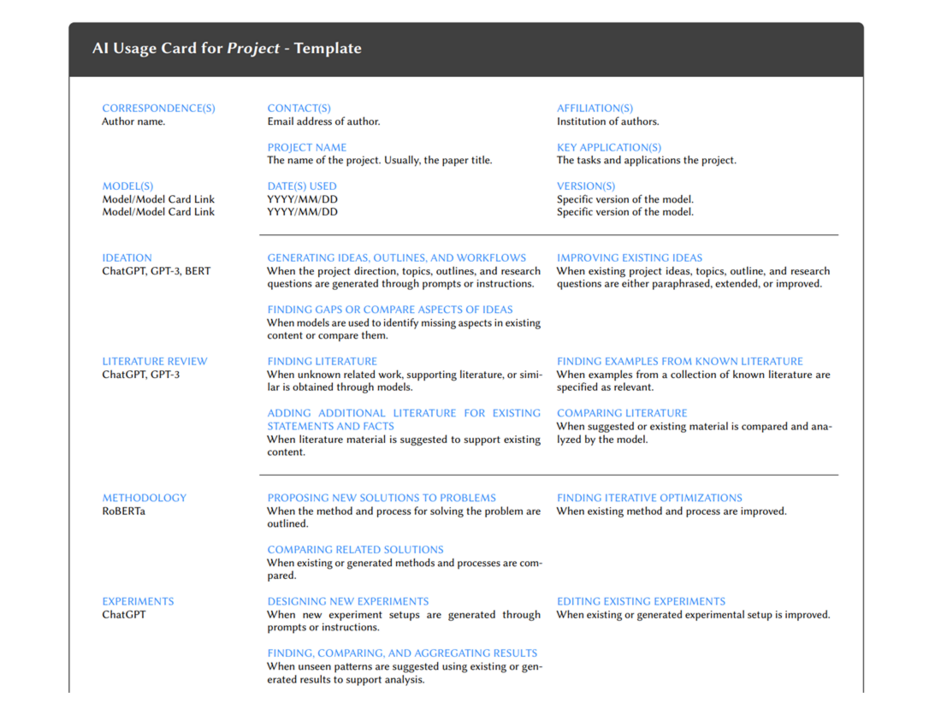Options for labeling, documenting and reflecting on the use of AI
Various methods are currently being tested in different disciplines to document the use of AI tools. In most disciplines, however, there is still no consensus on how the use of generative AI technologies should be documented and labeled. Here we present various ways in which writers can document and label their use of AI in writing and research processes. Regardless of which labeling option you choose, it is essential that you always document the use of generative AI applications. It is also recommended that you save all generated research-relevant products outside of the tools used. Especially in the case of longer work processes, documentation can ensure that your knowledge process remains traceable for yourself and that you can assess how significant the contribution of AI systems was to your results.
This page lists various options for documenting and labeling AI usage, which can also be combined with each other. In addition to a brief description and an example, there is also a comparison of the advantages and disadvantages of the labeling methods.
- Students can use this page as a basis of information to label and document their use of AI applications. The prerequisite for this is that the use of AI corresponds to the framework conditions defined by the teacher.
- Teachers can use this page for guidance and as a decision-making aid to determine how students should document and label the use of generative AI in their work. Teachers may also find these text modules for syllabi helpful when positioning the use of AI by students.
General information on labeling AI usage can also be found on this overview page.
Status: 18.08.2025

Citation
Many common citation systems describe the handling of generative AI in their guidelines. You can use these guidelines to mark AI-generated text parts as direct or indirect citations (e.g. according to APA,Chicago Manual of Style,MLA).
Example APA (see this APA article)
Quote in the text:
When given a follow-up prompt of "What is a more accurate representation?" the ChatGPT-generated text indicated that "different brain regions work together to support various cognitive processes" and "the functional specialization of different regions can change in response to experience and environmental factors" (OpenAI, 2023; see Appendix A for the full transcript).
In the bibliography:
OpenAI. (2023). ChatGPT (Mar 14 version) [Large language model]. https://chat.openai.com/chat

Advantages
- The AI system used, including the version, is usually specified in the bibliography.
- The citations can be combined with a prompt history in the appendix, which also allows readers to understand the context of the cited passages. Another option is to share one or more links to the entire prompt history, as long as it is ensured that the information is available there in the long term.
- Direct citations can be clearly indicated with quotes (especially if a full prompt history is attached).
- If AI is used as a primary source, direct quotations are suitable for marking the adopted text passages (especially if a complete prompt log is attached).
Disadvantages
- AI-generated texts are not actually academic sources and therefore cannot be cited in the conventional sense:
"AI-generated texts are [...] unique items which - in contrast to previous forms of citation - cannot be reproduced in the context of performance assessments and [therefore] cannot be cited and looked up (like conventional text passages)" (see orientation framework). - It is complicated to label indirect quotations (paraphrased content from AI-generated texts).
- It is difficult to label revised AI-generated texts with citations.
- It is difficult to use citations to identify research-relevant products that are not texts in the narrower sense (e.g. impulses for research questions, suggestions for literature research).
- If no prompt log is attached, the interaction with the AI system is not specified and it remains unclear which prompt was used to generate the text and what the proportion of human input was.
- Quotes cannot be used to reflect AI usage.
- It is only possible to cite an AI application if it is publicly available (i.e. at least available for purchase). A citation is not sufficient to document the use of self-programmed AI applications because readers may not have access to the software or the technical background. In the case of self-programmed AI systems, publicly accessible technical documentation would also be required.
Description of AI utilization in your writing
You can describe directly in the main text of your paper how you have used generative AI in the work process (e.g., in the methodology section, in the introduction, or in footnotes). In this case, it is quite possible to illustrate for each phase of the work and research process how, and with what results, you have used an AI application for the respective step (e.g., for brainstorming, literature review, text production, text revision,...).
Example short version
"When writing this article, the authors used ChatGPT, Grammarly, DeepL and Microsoft Word to improve the linguistic formulation. The authors are responsible for the content." (see orientation framework)
Example chapter on the research question
"When finalizing the research question, I used ChatGPT (version 4.0) to get impulses for narrowing down the research question. The dialog with ChatGPT gave me the idea to focus on ... in my work (see prompt protocol in the appendix)."
Example excerpt from a literature review
"The first phase of the literature review was exploratory. The AI-based literature search tool Research Rabbit was used to visualize references between the basic texts by Latour (1979) and Callon (1984) (see screenshot in the appendix). The network-shaped visualization showed that actor-network theory has differentiated into several strands of discussion in recent decades. Key terms were derived from these lines of discussion and used in the further systematic literature research."

Advantages
- You can describe exactly how and with what result you used generative AI. For example, you can summarize your prompts and describe how the interaction with the AI affected your work process.
- This method is very flexible: it is suitable for describing the use of generative AI as a tool for different steps, not just in the context of text production.
- The description can be more detailed or shorter, depending on the type of text and the subject-specific conventions.
- The description of AI use encourages students to reflect on the implications of AI use for the writing process, which can further develop their own writing skills.
- In the description, you can explain all the elements required by the framework: the AI system, the version used and the specific interaction with the AI.
- This method can be combined with a prompt log in the appendix, which allows readers to trace the entire interaction with the AI.
Description of use in the appendix of the paper
You can describe your use of AI in the appendix of the thesis, which makes it easier to document your use of AI precisely. For each phase of the work and research process, you can describe how and with what result you used an AI application for the respective work step (e.g. for brainstorming, literature research, text production, text revision,...).
Examples of forms of presentation of AI use in the appendix of the paper
- Description of the prompts used (e.g. "Please give me feedback on the following text and make suggestions on how I can simplify the long sentences.") and results
- Documentation of the complete chat history with the AI tool (e.g. ChatGPT, Copilot, Google Bard/Gemini). With some tools, it is possible to obtain a publicly accessible link to the full chat history. If you share a link to the chat history, it is important to ensure that the information can be accessed there in the long term.
- Screenshots of the AI application used (however, these are not barrier-free, i.e. cannot be read with a screen reader)
- Research diary in which you regularly describe and reflect on the use of AI
- Description of AI use using reflection questions (see e.g. Reflection questions for students)
- Documentation table (see next example)

Advantages
- You can describe in detail how and with what results you have used generative AI. For example, you can summarize your prompts and describe how the interaction with the AI affected your work process.
- This method is very flexible: it is suitable for describing the use of generative AI as a tool for different work phases, not just in the context of text production.
- Describing the use of AI encourages you to reflect on the implications of AI use on the writing process, which can further develop your own writing skills.
- In the description, you can explain all the elements required by the framework: the AI system, the version used and the specific interaction with the AI.
- The description in the appendix can be adapted to the respective text type and subject-specific requirements.
Disadvantages
- It may not be clear from the main text of the paper how generative AI was used in the research process.
- If you describe your use of AI in great detail or include prompt logs in the appendix, readers will gain an insight into the development process of your text. For example, prompt logs and reflections may contain immature thought processes or rough drafts of text, which can be associated with shame for the authors and can make it difficult to fully and truthfully describe AI use.
- If you use generative AI very intensively, it can be challenging to present all forms of use clearly.
- Long descriptions can make it difficult for readers to quickly grasp how AI was used in the research process and how individual key decisions were made.
- Long prompt logs are confusing for readers. For references to the prompt protocol to be comprehensible for readers, it would almost need a reference to the corresponding page in the prompt protocol, which in turn would be tedious for the writers.
Documentation table
You can summarize your AI usage in a documentation table in the appendix of your work. For each phase of the work and research process, you can describe how and with what result you used an AI application for the respective work step (e.g. for brainstorming, literature research, text production, text revision,...).

Advantages
- You can describe in detail how and with what results you have used generative AI. For example, you can summarize your prompts and describe how the interaction with the AI affected your work process.
- This method is very flexible: it is suitable for describing the use of generative AI as a tool for different work steps, not just in the context of text production.
- Describing the use of AI encourages you to reflect on the implications of AI use on the writing process, which can further develop your own writing skills.
- In the documentation table, you can explain all the elements required by the framework: the AI system, the version used and the specific interaction with the AI.
Disadvantages
- It may not be clear from the main text of the paper how generative AI was used in the research process.
- If you use generative AI very intensively, it can be challenging to present all forms of use clearly.
- Long descriptions can make it difficult for readers to quickly grasp how AI was used in the research process and how individual key decisions were made.
Example: Documentation table
Generative AI application | Work phase | Use: How did I use AI? | Comment on use or result | Reflection: What worked well? What would I do differently next time? |
ChatGPT (Version 4.0) | Conception | Dialogue with ChatGPT on my research question with the aim of getting ideas for possible focuses (see prompt protocol in the appendix). | Decision to concentrate on ... in further work and to search for further relevant literature. |
|
ChatGPT (Version 4.0) | Writing an abstract | I asked ChatGPT to write an abstract for my paper based on a list of keywords (see prompt in the appendix). | The result was far too general, I could not use ChatGPT's text because it did not fit my discipline. However, the text was helpful for me to see how I could structure the abstract. I then structured my abstract in a similar way, but formulated it completely differently. | Rather ask ChatGPT about the structure of an abstract. |
Research Rabbit | Literature research | Visualization of references between the basic texts by Latour (1979) and Callon (1984) (see screenshot in the appendix). | The network-shaped visualization showed that actor-network theory has differentiated into several strands of discussion in recent decades. Key terms were derived from these lines of discussion, which were used in the further systematic literature research. |
|
Grammarly | Final correction of the work | Grammatical and orthographic review of the complete work | Adoption of most of the suggestions from Grammarly | / |
The table above is partly based on this guide from the University of Basel.
AI Usage Cards
The AI Usage Cards are a systematic and partially standardized documentation system for marking AI usage in research and writing projects. The documentation system is based on a three-dimensional model (transparency, integrity, accountability) that encourages reflection on responsible AI use in research.
The AI Usage Cards can be created via a short online questionnaire. The questionnaire uses various questions on the use of AI applications in the different phases of the work process to record the use of AI and its impact on the research process. The results are then automatically displayed in a clear table.
This white paper by Wahle et al. (2023) explains the theoretical background of the AI Usage Cards and contains detailed information on the project.

Advantages
- The AI Usage Cards enable systematic documentation of AI usage in the various phases of the research process (not just text production).
- The standardized presentation makes it easier to get a quick overview of AI usage. This also makes it easier to compare texts and work processes with regard to AI use.
- The AI Usage Cards can be easily created using the online questionnaire.
- The AI Usage Cards contain a description of the type of usage and its impact on the research process. For example, a distinction is made between different uses of AI applications (e.g. you can indicate whether you have used AI to "generate new" or "improve" ideas).
- It is a concern of the AI Usage Cards to consider ethical dimensions of AI use.
- The AI Usage Cards can be used to reflect on the use of AI.
Disadvantages
- The questionnaire for creating the AI Usage Cards is currently only available in English.
- AI Usage Cards are only useful if the AI usage has already been documented during the work process so that the questionnaire can be completed in full.
- The standardized documentation system requires you to describe your own usage in such a way that it fits the categories of the usage cards.
Academic Integrity Statement
In an academic integrity statement, authors affirm with their signature that they have written their work independently and without outside help in accordance with the principles of good academic practice and have fully cited all sources and any software used.
If you submit a thesis (BA thesis, MA thesis/diploma thesis or dissertation) for assessment at the University of Graz, you must always submit an academic integrity statement (affidavit) (see e.g. Instructions for submitting a BA thesis), regardless of whether you have used generative AI for your work or not. At the University of Graz, you sign this academic integrity statement electronically via UNIGRAZonline when you submit your thesis. In this statement, you confirm that you have fully cited all sources and any software used and work according to the principles of good academic practice. This also includes avoiding any violation of the obligation to label the used software and the way it is utilized. It implies that you must always describe your use of AI in your thesis (e.g. in the introduction or in the methods chapter), even if generative AI tools are not explicitly mentioned in the academic integrity statement.
Teachers can also require students to submit an academic integrity statement for other types of work (e.g. seminar papers, reflections or portfolios). These academic integrity statements can sometimes be expanded in terms of content in order to describe the use of AI in more detail.
Examples of academic integrity statements (in a slightly modified form from Glathe et al., 2023)
"I have only used the permitted and documented aids. I confirm that the labeling of the AI application is complete. I am fully responsible for the selection, adoption and all results of the AI-generated output I used. I have listed the AI tools used with their product names in the "Overview of tools used" directory. In the appendix I have
- the prompts I used,
- listed all AI-generated outputs individually [e.g. links to prompt histories],
- documented the use of the AI tools [see example on the following page] that were relevant to the task."
"I did not use any outputs from [text, image or code-generating] AI tools in the elaboration."
Many other AI-specific examples of academic integrity statements can be found here (FH Joanneum).
Example from the orientation framework (cf. Gimpel et al., 2023):
When writing this article, the authors used ChatGPT, Grammarly, DeepL and Microsoft Word to improve the linguistic formulation. Responsibility for the content lies with the authors.

Advantages
- The responsibility for the use of AI within the framework of good academic practice clearly lies with the authors and is also legally secured by the signature.
- AI use can be summarized in the academic integrity statement.
- Authors can also use an academic integrity statement to ensure that they have not used generative AI.
- This is particularly useful for students if lecturers require an academic integrity statement and provide students with guidelines for preparing an academic integrity statement.
Disadvantages
- It is usually not possible to describe the use of AI in detail in the academic integrity statement.
- Academic integrity statements are usually only signed after the work process has been completed and therefore do not encourage documentation or reflection on the effects of use during the work process.
- It is theoretically possible to simply sign academic integrity statements without actually working independently or adequately documenting AI use.
- If academic integrity statements are the only documentation method used, then it is not possible to trace which parts of the text were AI-generated or how significant the contribution of AI systems was in the work process.
Specify AI system as co-author of the text
In order to make it clear to readers that a generative AI system has made a significant contribution to the research process, some researchers cite the AI system as co-author of the text.
However, it is important to note that, from a copyright perspective, only natural persons (humans) can claim authorship of a text (Hoeren, 2023, p. 26f). For this reason, this practice is controversial and it is not advisable to list a generative AI application as a co-author in student texts.
Examples
There are already several published research articles that were written with ChatGPT and in which ChatGPT is listed as co-author (see e.g. this editorial and this article). In both cases, generative AI is also the subject of the articles.

Disadvantages
- The indication of co-authorship alone does not contain any concrete information about the type of interaction with the AI system. As a result, it remains unclear what specific contribution was made by the AI system.
- It is unclear whether the human authors are responsible for the content of the text.
- Listing an AI application as a co-author is currently not recommended by many researchers and scientific communities (see ChatGPT listed as author on research papers: many scientists disapprove; Best Practices for Using AI When Writing Scientific Manuscripts).

